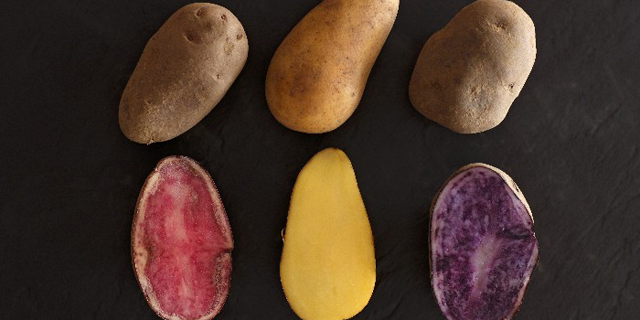Basically put: if the Great Plains are America’s breadbasket, Peru, the birthplace of all potatoes, is one of Earth’s original cornucopias. With 314 million tons cultivated worldwide in 2008 alone, they are among the top three most important crops according to human consumption. Ironically though, South America, produces the least amount of potatoes of any region in the world since most potato cultivation there is destined for domestic consumers. However, Peru more than makes up for quantity with…well, quantity. This country is home to over 3,000 known species of potatoes and surely more that have yet to be discovered.
So how did the potato spread from the isolated mountain tops of the Andes to almost every country in the world? As with most questions in Latin American history, the answer is: conquistadors. Researchers believe the potato was first cultivated somewhere between 4 to 7 centuries ago in the Andes around Peru’s Lake Titicaca (don’t laugh, it’s a real place!). In the 1500s, the Spanish brought potatoes back to Europe, where these tubers were considered ill-fit for humans and were used mainly to feed livestock. Fast forward a couple hundred years and one too many famines caused by grain shortages, Europeans looked to nutrient-dense, high-yielding potatoes for sustenance.
According to a study published in the Quarterly Journal of Economics, after the implementation of this dietary change, the European masses were finally well-fed and ready to ward off disease. Therefore, the potato, having given the masses a newfound stability, was responsible for more than a quarter of the population spike and urbanization of the 1700 to 1900s.
These potatoes and most others are energy-rich, versatile, inexpensive, low in saturated fat and high nutrients (Vitamin C, Vitamin B6, Manganese, and Potassium for example), so much so that they can feed a nation or bring it’s economy to its knees (sorry Ireland). Not bad for a plant that hides in the ground and looks like a rock. So instead of thoughtlessly guzzling drive-thru french fries, make an authentic Peruvian recipe that honors both the country’s history and its unique potato varieties!
Next up, the most popular Peruvian potatoes and how to use them!…
[pagebreak]
-
Huairo: These potatoes are easy to find anywhere in Peru and a key ingredient in many classic dishes. Why? They have a distinct flavor, absorb sauces well, and are very easy to work with. You can steam them, boil them, or bake them, and you simply must fry them; they get crispy on the outside and soft and silky on the inside. In the fiery spirit of summer grilling, boil and then grill huairos along side Tia Lucy’s Anticuchos for a taste of classic Peruvian street food. Or if your vegetarian recipes are what you seek, try out these Potato and Cheese Chile Rellenos for a meat-less treat.
-
Camotes (Peruvian Sweet Potatoes): Oh did you think that marshmallow-covered Thanksgiving side dish was from the US of A? Think again. Though camotes are only distantly related to traditional potatoes, they too originated in Peru, with evidence of their existence in Peruvian Moche ceramics that date back to 300 A.D. Peruvian camotes range in color from bright orange to white and are ideal substitutes for pumpkin and potatoes in any recipe. For a traditional and filling soup that warms you from the inside out, try this sweet and smoky Sopa de Camotes a la Arequipe or ditch your everyday potato salad for a Apple, Roasted Sweet Potato, and Jalapeño Salad that fuses tart Granny Smiths with sweet and creamy sweet potatoes.
-
Papa Púrpura: It’s iconic amethyst hue and history as a favorite of the Incan royalty earned papas púrpuras the sobriquet “Gem of the Andes”. Besides adding a gorgeous blueish-purple pop of color, they also give dishes a nutty flavor. Nutritionally, these spuds have 4 times as many antioxidants than your average russet…they also have more starch though, so weigh the pros and cons. Potatoes in this family are very firm and moist, making them great for roasting, as proved by this hearty Balsamic Root Vegetables recipe. Because they hold their shape so well, they are also ideal for potato salads; venture off the beaten path with this simple Peruvian Purple Potato and Scallion Salad.
- Papa Peruanita: Besides their distinctly small, round shape, these potatoes are best known for their red and whitish yellow spots, colors which parallel the Peruvian flag, giving this breed its name (“little Peruvian”). Because their skin is so thin, leave their patriotic hide untouched and go straight for the pot with these. Best if baked or boiled, they add a mild buttery sweet taste, become fluffy when mashed, and are great natural thickeners for stews. But whatever you do, don’t slice them up and serve them alongside your burger, they change color and develop a different flavor when deep fried. Instead, give them a shot in this Papa a la Huancaina recipe, an iconic Peruvian side dripping in spicy cheese sauce (drool). Or if you want to keep things light (though why you would do that when there’s the possibility of spicy cheese sauce) you can also try peruanitas in this figure-friendly Healthy Peruvian Beef Stew.


![Making Mealtime Matter with La Familia: Easy Sofrito [Video]](https://thelatinkitchen.com/wp-content/uploads/2015/10/sofrito-shutterstock__0-500x383.jpg)
![Easy Latin Smoothies: Goji Berry Smoothie [Video]](https://thelatinkitchen.com/wp-content/uploads/2015/12/goji_berry-shutterstock_-500x383.jpg)
















![Fun and Fast Recipes: Fiesta Cabbage Salad [Video]](https://thelatinkitchen.com/wp-content/uploads/2015/11/fiesta_cabbage_slaw-shutterstock_-500x383.jpg)









